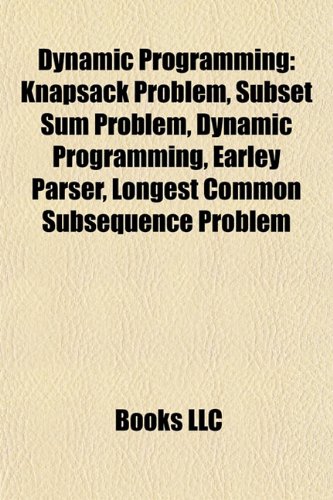Articoli correlati a Dynamic programming: Knapsack problem, Subset sum problem,...
Dynamic programming: Knapsack problem, Subset sum problem, Earley parser, Longest common subsequence problem, Forward-backward algorithm - Brossura

Reseña del editor:
Please note that the content of this book primarily consists of articles available from Wikipedia or other free sources online. Pages: 52. Chapters: Knapsack problem, Subset sum problem, Earley parser, Longest common subsequence problem, Forward-backward algorithm, Viterbi algorithm, Bellman equation, Floyd-Warshall algorithm, Smith-Waterman algorithm, Levenshtein distance, Markov decision process, Matrix chain multiplication, Longest increasing subsequence, Approximate string matching, Word wrap, Backward induction, Partially observable Markov decision process, Needleman-Wunsch algorithm, Curse of dimensionality, Longest common substring problem, Hamilton-Jacobi-Bellman equation, Hirschberg's algorithm, Optimal stopping, Optimal substructure, Maximum subarray problem, Viscosity solution, Bitonic tour, Shortest common supersequence, Hunt-McIlroy algorithm, Overlapping subproblem. Excerpt: In mathematics and computer science, dynamic programming is a method for solving complex problems by breaking them down into simpler subproblems. It is applicable to problems exhibiting the properties of overlapping subproblems which are only slightly smaller and optimal substructure (described below). When applicable, the method takes far less time than naive methods. The key idea behind dynamic programming is quite simple. In general, to solve a given problem, we need to solve different parts of the problem (subproblems), then combine the solutions of the subproblems to reach an overall solution. Often, many of these subproblems are really the same. The dynamic programming approach seeks to solve each subproblem only once, thus reducing the number of computations. This is especially useful when the number of repeating subproblems is exponentially large. Top-down dynamic programming simply means storing the results of certain calculations, which are later used again since the completed calculation is a sub-problem of a larger calculation. Bottom-up dynamic programming involves...
Le informazioni nella sezione "Su questo libro" possono far riferimento a edizioni diverse di questo titolo.
- EditoreBooks LLC, Wiki Series
- Data di pubblicazione2011
- ISBN 10 1155768469
- ISBN 13 9781155768465
- RilegaturaTapa blanda
- Numero di pagine54
(nessuna copia disponibile)
Cerca: Inserisci un desiderataSe non trovi il libro che cerchi su AbeBooks possiamo cercarlo per te automaticamente ad ogni aggiornamento del nostro sito. Se il libro è ancora reperibile da qualche parte, lo troveremo!
Inserisci un desiderata